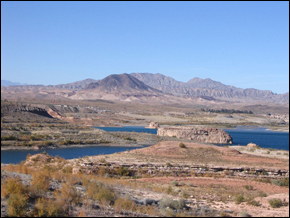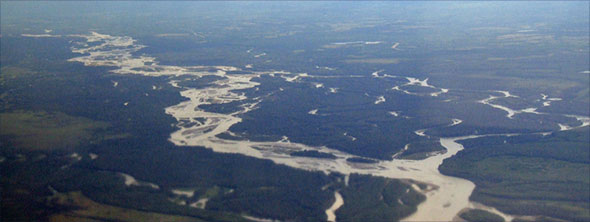Good Snow Season Triggers Bonus Water for Lake Mead
The reservoir is expected to rise nearly 30 feet, and power output at the Hoover Dam will increase as well.

Thanks to a favorable snowpack in the upper reaches of the Colorado River Basin, Lake Mead—the reservoir supplying Las Vegas with drinking water and powering the Hoover Dam—will rise nearly 30 feet from last year, according to an operating plan published Friday by the U.S. Bureau of Reclamation.
Precipitation in the Rocky Mountain watersheds that flow into the Colorado River is 20 percent above normal this year, giving the states that rely on Lake Mead as a source of water and power a reason to cheer. The lake supplies farms, industries, and municipalities in Arizona, California, and Nevada.
The extra slug of water will avert, for now, the threat of a first-ever shortage declaration on the river’s lower basin. Hoover Dam, which saw its output plummet in tandem with the reservoir last September, will be able to generate 6.5 percent more electricity this year, according to projections.
The long-term supply and demand challenges, however, still remain.
Since 2003, water use from the river has exceeded average supply. And the ten main reservoirs located within the basin are at 53 percent of water storage capacity, combined.
As a result of a 2007 settlement, operations at Lake Mead and its upstream counterpart, Lake Powell, have been tied together. River managers are required, by law, to release 10.2 billion cubic meters (8.23 million acre-feet) each year from Lake Powell to meet downstream delivery obligations. Water levels for both reservoirs are forecast every month, and the April forecast is used to determine releases for the rest of the water year, which ends September 30.
If the water level at Powell is above a certain threshold after the mandated releases, more water is allocated to Mead in order to “equalize” the reservoirs. Such is the case this year—the U.S. Bureau of Reclamation, the federal agency that manages the Colorado River, will release 14.3 billion cubic meters (11.56 million acre-feet) from Lake Powell to Lake Mead during the 2011 water year. With the bonus water, river managers project that the elevation in November 2011 will be 1,109 feet.
In November 2010, the reservoir’s surface dropped to an elevation of 1,082 feet—its lowest level since the filling of the reservoir first began in the 1930s.
River managers will continue to update the operating plan throughout the summer to reflect any hydrological changes.
Brett writes about agriculture, energy, infrastructure, and the politics and economics of water in the United States. He also writes the Federal Water Tap, Circle of Blue’s weekly digest of U.S. government water news. He is the winner of two Society of Environmental Journalists reporting awards, one of the top honors in American environmental journalism: first place for explanatory reporting for a series on septic system pollution in the United States(2016) and third place for beat reporting in a small market (2014). He received the Sierra Club’s Distinguished Service Award in 2018. Brett lives in Seattle, where he hikes the mountains and bakes pies. Contact Brett Walton






FYI…Reclamation is properly identified as the “federal” Bureau of Reclamation, not the U.S. Bureau of Reclamation.
Better change the url from *usbr* to something more in line with the *federal* Bureau of Investigation – http://www.fbi.gov/ – to avoid any confusion. Thanks, Kip.